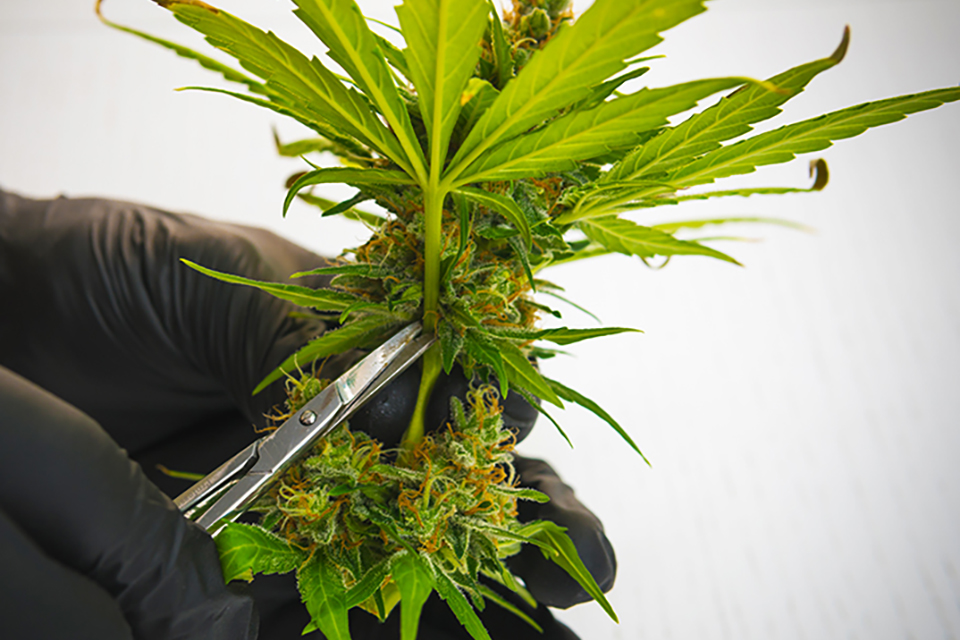
Trimming cannabis plants is integral to the cultivation process and can significantly impact the final product. One decision that home growers must make is whether to opt for wet or dry trimming. Wet and dry trimming methods have different advantages and drawbacks. Choosing the best method for your cannabis plants will help you to achieve optimal results.
Wet Trimming
As the name implies, wet trimming is the process of removing excess foliage from cannabis plants while they are still fresh and wet, typically immediately after harvest. Many growers prefer this method, but it also has its unique set of benefits and challenges.
Process of Wet Trimming
Wet trimming your cannabis plants is a straightforward process. Begin by cutting down your plant and trimming off the larger fan leaves. Use a precision trimmer to remove the smaller sugar leaves that are closer to the buds. Trichomes often coat sugar leaves and contain valuable cannabinoids, making it important to trim them carefully to avoid losing any of these potent compounds.
Remember that during wet trimming, the plant material will be quite sticky, so your trimmers will need to be regularly cleaned. After trimming, you must hang the buds to dry. This process typically takes between five and ten days, depending on the environmental conditions.
Advantages and Drawbacks
There are several advantages to the wet trimming method. For one, it’s generally easier to trim wet cannabis plants, as the leaves are more rigid and stand out from the bud. Wet-trimmed buds are often more aesthetically pleasing, as this method allows for a tighter trim, creating a more manicured end product.
However, wet trimming has its drawbacks. The process can be time-consuming, and trimming must occur immediately after harvest to prevent the leaves from drying and curling into the buds. This immediacy can increase labor demands, especially for larger grows. Some growers believe that wet trimming can lead to a faster drying process, which may affect the final taste and aroma of the buds.
Dry Trimming
The alternative to wet trimming is dry trimming, which involves trimming foliage from cannabis plants once they have sufficiently dried post-harvest. The dry trimming method has unique considerations for cannabis cultivators.
Process of Dry Trimming
Dry trimming occurs after the cannabis plants dry, generally over a period of ten to fourteen days. Once the plants have dried, cultivators remove the large fan, followed by the smaller sugar leaves. Dry buds are less sticky, making the trimming process less messy than wet trimming. However, dry trimming requires more delicacy to avoid damaging the brittle leaves and buds.
Like wet trimming, it’s good to note that trichomes will still cover the sugar leaves, so careful trimming will help preserve these valuable compounds. Following trimming, cultivators store the buds in airtight jars to cure and improve their flavor, aroma, and overall quality.
Advantages and Drawbacks
One key advantage of dry trimming is that it can allow for a more gradual drying process. A slower drying can help preserve and enhance the aroma and flavor of the final product. As the buds have already dried, there is less urgency in the trimming process, which may reduce labor pressure.
On the other hand, dry trimming can be more difficult than the wet method, as the leaves may shrink and curl up around the bud, making them harder to access and trim. The dry trimming process can also be more time-consuming and necessitates careful handling to prevent the loss of trichomes or damage to the product. Dry-trimmed buds may also lack the neat, manicured appearance of those that have been wet-trimmed.
Factors to Consider When Choosing Trimming Method
When deciding between wet and dry trimming your cannabis plants, growers should consider several factors. The characteristics of the plant itself can influence your decision. Some strains have more foliage than others, making them more suitable for wet trimming. Conversely, strains with a more open structure and less foliage might be better suited to dry trimming.
Environmental conditions are another important consideration. If you are growing in a humid environment, wet trimming can help prevent mold and mildew because it speeds up the drying process. On the other hand, growing rooms in dry climates may benefit from dry trimming as it allows the buds to retain moisture and slow the drying process, enhancing the end product’s flavor and aroma.
Best Practices for Trimming Cannabis Plants
Regardless of the trimming method you choose, having the right tools and equipment can make the process much smoother. Precision trimmers, sharp scissors, and cleaning supplies are all essential for effective trimming. Always clean your equipment before use and regularly during trimming to avoid resin buildup.
Quality Trimming Begets Quality Cannabis
For home growers, it’s recommended to experiment with both methods to see which achieves the best result for their specific plants and growing conditions. Regardless of the method chosen, using the right tools, following good techniques, and maintaining a clean workspace can significantly enhance the trimming process. Trimming is a necessary step in cannabis cultivation, and understanding the dynamics of wet vs dry trimming can help home growers produce high-quality cannabis.



